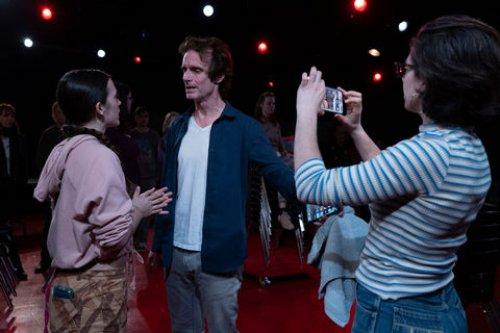Rocco, Chelsea, Adriana, Sean, Claudia, Gianna, Alex
An attempt at an experimental theater piece whose many intercut vignettes on hot button issues would be more suited to a documentary film than to the stage.

Kaelyn Ambert-Gonzalez, Scott McCord and Talya Mar in a scene from Dan Hasse’s “Rocco, Chelsea, Adriana, Sean, Claudia, Gianna, Alex” at HERE Arts Center (Photo credit: Max Gordon)
[avatar user=”Victor Gluck” size=”96″ align=”left” ] Victor Gluck, Editor-in-Chief[/avatar]Being described as a “theatre event,” the unwieldy titled Rocco, Chelsea, Adriana, Sean, Claudia, Gianna, Alex is a throwback to the happenings and performance art of the 1960’s, without having the same visceral effect. Based on original work by the devising company, playwright Dan Hasse attempts to be up to the minute by including a great many hot button issues, but the endless scenes and vignettes seem to be part of a checkoff list of items to include rather than any great need to link these disparate topics.
John Gould Rubin’s minimalist production which moves the audience around for the second half of the evening, as well as wasting a good deal of time making the actors rearrange the tables and chairs (the only scenery) into different configurations, does not do the material a service by his choices. The use of nine actors to play 26 characters (who do not change costumes or appearances) makes it extremely difficult to follow the many intercut stories being told which appear to be going on simultaneously. During the second half of the evening while the audience is asked to walk around the now open playing area, more than one scene is enacted at a time, making the play even more difficult to follow.

Chuck Montgomery and Chuk Obasi in a scene from Dan Hasse’s “Rocco, Chelsea, Adriana, Sean, Claudia, Gianna, Alex” (Photo credit: Max Gordon)
When the audience arrives at HERE Arts Center, they are asked to check all of their belongings as they will not be seated in the same place throughout. The upstairs venue at HERE has been reconfigured as a black box with tables running around the four walls and a red playing area in the center. At each seat (which are assigned randomly) are pages from the New York Times depicting current events. When the play begins, various actors (who turn out to have been sitting among the audience all along) get up to enact their scenes. Initially the actors deliver their lines in place but eventually, tables are pushed out of the way and actors enter the central space for their scenes. Projections, streaming video and live feeds appear on three walls but cannot be seen by audience members on that side of the venue.

Emily Jackson, Melissa Mickens and Kaelyn Ambert-Gonzalez (clockwise from top) in a scene from Dan Hasse’s “Rocco, Chelsea, Adriana, Sean, Claudia, Gianna, Alex” (Photo credit: Max Gordon)
The scenes are on the topics of such headline-grabbing issues as homosexuality, immigration and naturalization, AIDS, drug addiction, domestic abuse, shock radio, video pornography, adoptees seeking their biological parents, and the effects of 9/11. There may simply be too many topics to deal with in anything but a documentary. No one involved in this production seems to have realized you can’t cover every issue in one evening.
The nine actors (Adrian Baidoo, Kaelyn Ambert-Gonzalez, Emily Jackson, Talya Mar, Scott McCord, Melissa Mickens, Chuck Montgomery, Chuk Obasi and Adriana Rossetto) are fine but as their performances are so fragmented in what the author calls the “tapestry-style structure of the play,” it is very difficult to keep the pieces straight. In the second half the same characters recur but as there are so many stories going and actors appear in more than one, it is not easy to put the pieces together. Even more confusing is the overlapping of scenes so that the viewer has to choose to listen to one and miss another. The use of no scenery except the tables and chairs makes it difficult to follow the play except for the two audition scenes, and the radio interview which are fairly obvious.
The large production team includes Liz Toonkel (scenic and costume design), Erin Earle Fleming (lighting design), Drew Weinstein (sound design), Elizabeth Mak (projection and video design), and Ray Sun (video consultant). The evening was created by Vieve Radha Price and The Private Theatre’s artistic director John Gould Rubin. If you are familiar and attuned to avant-garde and experimental theater, you may have no trouble following this play. Other theatergoers ought to beware of what they are in for as they may have trouble synthesizing all the pieces to this theatrical puzzle.
Rocco, Chelsea, Adriana, Sean, Claudia, Gianna, Alex (through March 9, 2019)
The Private Theatre, in association with TÉA Creative
HERE Arts Center, 145 Sixth Avenue, one block south of Spring Street, in Manhattan
For tickets, call 212-352-3101 or visit http://www.here.org
Running time: two hours and five minutes with one intermission






Leave a comment